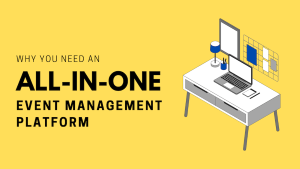
Online and hybrid events have been growing in popularity for some time, but the arrival of COVID-19 forced many businesses to add an online component when hosting events and conferences.
Companies that had not considered online or hybrid events before soon realized they deliver a range of benefits, such as an extended reach and adding more seats without needing a larger venue. Plus, the online portion of the event can take over as the showrunner should a lockdown come into play.
If you are considering a hybrid event for your next function or conference, Keep these tips in mind to ensure your hybrid event is a successful one.
What is a Hybrid Event?
Hybrid is a term used to describe a combination of two or more things. A hybrid event combines a live event and an online virtual event. Attendees have the option of showing up to a physical location or viewing the presentations and connecting with sponsors through software running on mobile devices and PCs.
A typical example of a hybrid event is a conference hosted in person at a conference hall with the addition of technology that streams the presentations to viewers online who cannot physically attend.
The above is a fairly straightforward option for a hybrid event. However, when you use the right online platform software, you can access a virtual component for almost every facet of an event, such as virtual sponsor booths, networking, and one-one chatting and video conferencing capabilities.
Why Host a Virtual Event?
Online events cannot entirely replicate the personal connections of a physical event. Guests at online events also don’t get to enjoy the decorations, amenities, food, beverages, and entertainment of a physically hosted event.
However, online conferences offer unique benefits, with perhaps the most important being the removal of geographical limitations. Organizers can benefit from an extended reach that gives them access to prospects and leads who may live hundreds or even thousands of miles away.
You also gain access to speakers and other talents that may not be able to physically attend but have no problem setting up a camera to deliver a presentation over the internet.
Because you are streaming material over the internet through a hybrid event, you have many options not possible with an exclusively physical conference.
Online engagement creates data, which gives you analytical views into what worked and what didn’t pan out as well as you hoped. You can use this data to make your next hybrid event even more popular and successful.
Hybrid Event Challenges
Making yourself aware of the challenges associated with virtual events will help you prepare in advance. When you know what can go wrong, you can create contingency plans for anything that may threaten the success of your event.
1. Time Zones
We’ve already mentioned one benefit of a hybrid event is that you can reach a broader audience living in different time zones. However, this can make it challenging, if not impossible, to find a time that will be convenient for everybody. One strategy to handle time zones is to record the live session and make it available for international attendees later in the day or evening.
2. Attendee Engagement
Many attendees go to events for networking opportunities. Virtual networking is not as straightforward as getting a crowd of people in the same room, but there are reasonable facsimiles for engagement when using suitable event hosting software.
3. Venue Space
You may have enough space to host everybody physically attending, but is there enough room for the AV equipment and streaming hardware? You will have technicians milling about as well, so any venue you choose should have room enough that everyone can stay out of each other’s way.
4. Accessibility
Unlike a purely online event, a hybrid event means you still have the headaches of ensuring enough parking and seating for your guests and everyone involved in running the event. Some of the main accessibility challenges you will face include:
- Priority seating
- Wheelchair and ramp access
- Assisted listening
- Interpreters
Some of the issues for accomodating your virtual attendees could consist of:
- Captioning software for multilanguage support
- Subtitles
- Font sizes
- Magnification accessibility options
Choose Event Software with The Features You Need
Hybrid events have a complex weave of interconnected parts, so the online event software you use plays a critical role in its success.
Because there is a physical and an online component, your online audience will be relying on the event technology platform you choose, so you should take the time to ensure it has all the features you need.
You likely won’t have access to unlimited bandwidth, but you will still need to deliver presentations simultaneously to a sizeable audience. Good online event software should have the capacity to host at least 500 attendees.
Depending on how you organize your schedule, the capacity to host multiple simultaneous presentations will give you the flexibility you need.
A big drawcard for physically hosted events is the sponsor booths where your sponsors can engage with the local foot traffic. Virtual booths are an analogous alternative that allows attendees to engage with your sponsors in real-time, even though they may be a couple of states over.
When you are organizing a hosting event, you may as well take advantage of the data that an online event will give you access to.
Ensure you can record your presentations and conferences, as these can create extra revenue streams for premium ticket sales or the creation of a digital product bundle you can later sell or use as a lead capture device.
Do A Dry Run – Or Several
Physically hosted events can be complicated, and even more so when you add streaming technology to the mix.
You will need to have a deep understanding of how everything will work together, which can be challenging if it’s your first time hosting a hybrid event.
Schedule a dry run before the event goes live, especially if you are working with remote presenters who will not be on site. Sponsors should also get involved so they can feel comfortable with what they need to do on the day.
Try to do more than one dry run if you have the time, as this is likely to highlight where things may go wrong, or where to make improvements.
Get Your Sponsors Involved
Sponsors are an excellent source of revenue but funding is not all they are good for. Your sponsors will also appreciate being able to get involved with event marketing, promotion, and brand management.
They may also have event hosting experience that they are willing to share and tips on preparing and hosting a successful event. After all, a poor experience could also reflect badly on them, especially if you are hosting a corporate event where reputation is everything.
Keep It Simple
When you have the technology and the expertise, it’s tempting to try and engage your audience with every trick in the book. Not only will this make your hybrid event a lot more complex, but it also has the potential to overwhelm your audience.
After attendees purchase their live or virtual event tickets, keep the communication lines open leading up to opening day. Send clear instructions about what they should do next, such as where to park, and time and logon details for your online presentations.
Segregate your audience if you have multiple conferences or presentations, so they only receive the information that is relevant to them. Online event software that integrates with Google Calendar can reduce the chance your attendees will forget and miss out.
Record and Analyze Your Data
As mentioned, your opportunities for analyzing the event’s performance through analytical data will create a lot of opportunities.
Your data can show you a lot more information than just ticket sales. Online hybrid event software will tell you where attendees spent most of their time, who your most popular sponsors were, the industries they work in, how they interacted with speakers, and the questions they ask during live chats or video presentations.
Polling features increase engagement with your audience who will appreciate the opportunity to have their say. A lot of the information they provide will give you excellent insights into how you can improve your next hybrid event.
Plan Your Content Delivery
How you deliver your live and online content will play a pivotal role in how your attendees engage with your event.
Speaker sessions, breakouts, and keynotes that will benefit from live audience engagement may work best as a live stream where the audience can engage in real-time. Other content could be pre-recorded, which is handy for attendees in different time zones.
Your sponsors will also appreciate content creation options that allow them to customize their content according to their brand.
Incorporate social media feeds, live Q and A sessions, and live chats at both your physical and virtual locations to ensure your audience has plenty of opportunities to engage. Hosting multiple live sessions will also give your international audience a chance to participate at a convenient time.
Create Interactive Virtual Booths
In-person attendees have the luxury of walking up to a booth and engaging with the company representatives. However, things are not as straightforward with the online component of a hybrid event, but event organizers do have a virtual equivalent when using good online event management software.
Virtual booths allow online attendees to explore virtual stands and visit online profiles to chat with representatives, browse their products, join a conversation, and explore company material such as PDF brochures and pre-recorded videos. Company representatives can easily request contact details so they can follow up on potential business opportunities.
Follow Ups After The Event
Don’t let the visitors to your hybrid event wander off into the sunset, never to be seen again. You have likely got their contact details and a wealth of other data that will prove useful in post-event marketing campaigns.
You can use the data to qualify leads based on their actions online and offline. Use touchpoints to assign a score that will help you determine which leads show the most promise for conversion and start working through your list.
You can reach out to schedule a consultation score and get more details about what your event visitor needs. Share relevant information, free trials, or a product demonstration to help them make an informed decision.
Ask visitors to join your online community, such as following you on Facebook or joining a Facebook group, subscribing to your YouTube channel, or joining your discussion on Twitter, Instagram, or LinkedIn.
Attendees to your previous events are also an excellent resource for bolstering ticket sales at your next event. Be sure to let them know well in advance. You can also enlist their help for spreading the word by offering incentives such as discounts, free tickets, or special pricing on your software or products.
Are You Considering a Hybrid Event?
Has the current market environment got you thinking about hosting a hybrid event for your next conference? Dryfta gives you all the capabilities you need to connect with your visitors through pre-recorded and live video sessions, virtual booths, integrations with the tools you already work with, and analytics for analyzing visitor behavior. Check out Dryfta Hybrid Event Toolkit today, and ensure the success of your next hybrid event.





